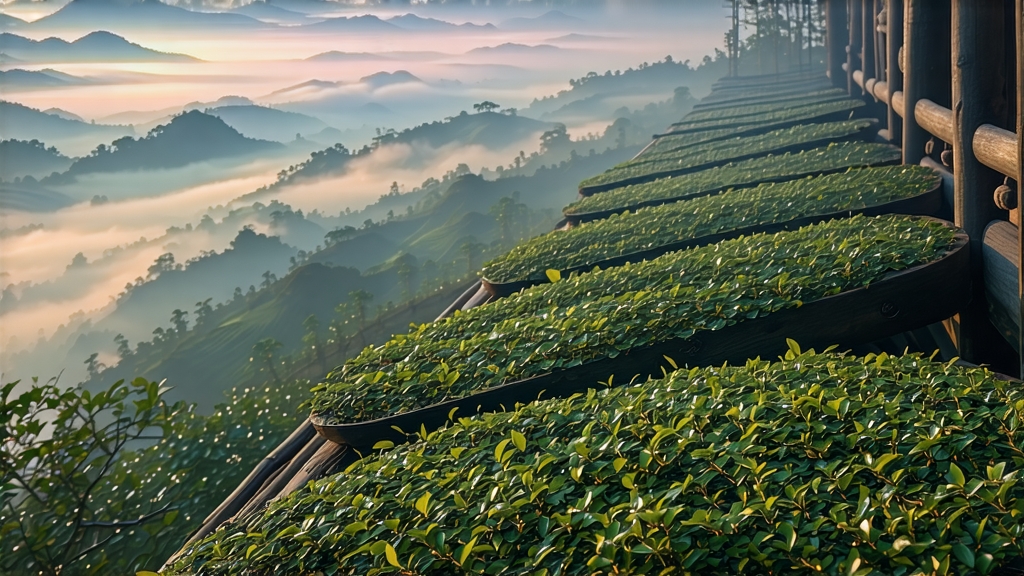
Lapsang Souchong—pronounced “lah-SAHNG soo-CHONG”—is the tea that startled Europe three centuries ago and still divides opinion today. To its admirers it is liquid campfire: a silky, resinous liquor that marries malted sweetness with the perfume of pine and cedar. To skeptics it is “tea that tastes like bacon.” Both camps agree on one point: no other black tea carries such a dramatic origin story, nor such an unmistakable aroma.
History: From Mountain Hermit to London Drawing Room
The written record begins in 1646, when monks in the Wuyi range of northern Fujian first described “xiao zhong”—literally “small variety”—a leaf lightly withered over local pine. Dutch traders carried it to Batavia (modern Jakarta), where the VOC shipped it to Amsterdam. By 1669 the East India Company had rebranded it “Bohea” (from the Min-dialect name for Wuyi) and auctioned it in London for prices higher than silver. Samuel Pepys drank it; Catherine of Braganza served it at court; and the House of Commons installed a locked tea-chest labeled “Lapsang” to prevent pilfering. The name itself is a Victorian hybrid: “Lapsang” is the Fuzhou pronunciation of lao shan (“old mountain”), while “Souchong” refers to the fourth and fifth leaves plucked lower on the bush—older, tougher material once deemed unfit for green tea but perfect for the robust black style.
Terroir: Where Rock Meets Mist
Authentic Lapsang Souchong can only come from the 600–1 200 m belt of the Tongmu Guan nature reserve, a fog-draped gorge where the Min River cuts through granite cliffs. Mean humidity hovers at 85 %; temperature swings between day and night reach 15 °C; and the soil is a shallow, acidic mix of weathered rock and pine needles. The indigenous cultivar is Xiao Ye Zhong (“small-leaf ancestor”), a slow-growing bush whose thick cuticle traps aromatic resins. Because the reserve lies inside a national park, every kilo of leaf is logged, and no synthetic agro-chemicals are permitted. The result is a tea that literally breathes the forest: air samples taken during firing show measurable quantities of α-pinene and limonene—the same terpenes that scent pine sap.
Two Styles: Smoke and No-Smoke
International buyers usually meet the smoked version, yet within China the preference has swung toward “unsmoked” or zheng shan xiao zhong. Both start identically: one bud and three leaves picked in late April, wilted on bamboo trays in the cool mountain air for 8–10 hours until 65 % of moisture is lost. The divergence occurs at the firing stage.
Traditional smoked Lapsang:
- Green-firing: Leaves are tossed for 3–4 minutes in a wok held at 200 °C to arrest oxidation.
- Rolling: A 45-minute knead breaks cell walls and releases juices.
- Oxidation: The leaf rests 2–3 hours in cedar-wood crates, turning mahogany.
- Pine-smoke drying: The crucial step. A pinewood fire is built on the floor of a three-storey Qing-dynasty loft; fresh leaves are spread on bamboo sieves two metres above. The fire is never allowed to flame—only to smoulder—while the tea master rakes embers every 20 minutes. Over the next 8 hours the leaves absorb volatile phenols (guaiacol, syringol) that create the signature tarry note.
Unsmoked zheng shan xiao zhong:
Instead of smoke, the leaf is dried with gentle 80 °C hot air in an electric oven. The cup profile shifts from campfire to longan fruit, honey and mineral rock—closer to a Wuyi rock oolong than to any black tea most Westerners know.
Chemistry in the Cup
Gas-chromatography studies reveal up to 42 distinct smoke-derived compounds in traditional Lapsang, the most sensorially active being 4-methyl-guaiacol, which humans can detect at 0.2 ppb—one reason why a single gram scents an entire room. Yet the tea is surprisingly low in tannins: the pine volatiles partially polymerise catechins, yielding a liquor that steeps for five minutes